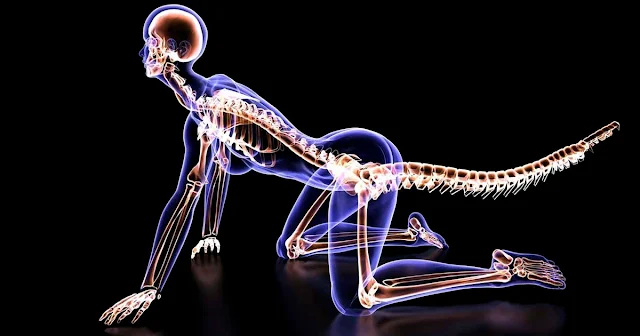One of the most remarkable changes in human evolution is the loss of our tails, a transformation that occurred around 25 million years ago. This pivotal shift not only altered the trajectory of our species but also marked a significant moment in the evolutionary history of primates. While scientists have long speculated on why humans lost their tails, the genetic cause has remained elusive—until now. A recent study published in Nature has finally uncovered the genetic factors responsible for this evolutionary change.

The Quest to Understand Tail Loss
The journey to unravel the mystery of human tail loss began in an unexpected way. Bo Xia, a graduate student at New York University, was inspired to investigate the origins of the human tailbone after injuring his own coccyx. This personal curiosity led Xia and his team to embark on a groundbreaking scientific investigation.
Through careful research, the team focused on the TBXT gene, which plays a crucial role in regulating tail length in various species. Their research revealed a unique genetic mutation within this gene, providing a major breakthrough in understanding human evolution.
The Role of Jumping Genes
A key aspect of this discovery lies in the role of Alu elements, often called “jumping genes.” These genetic elements, specific to primates, can move within the genome and cause significant changes. The researchers found that Alu elements inserted themselves into the TBXT gene, triggering a chain reaction that led to the loss of our tails.
This insertion activated a process known as alternative splicing, where RNA molecules are cut and restructured, which ultimately led to the deletion of a crucial exon. This change altered the structure and function of the resulting protein, leading to the tail loss seen in humans.
Validation Through Mice Studies
To confirm their findings, the researchers engineered laboratory mice with the same genetic mutations found in humans and apes. These genetically altered mice lost their tails, providing compelling evidence that the identified mutation plays a crucial role in the absence of tails in humans and other primates.
However, the study also uncovered a downside to tail loss: an increased risk of neural tube defects, such as spina bifida. This finding highlights the complex balance between evolutionary benefits and potential genetic trade-offs.
The Broader Implications
This discovery has profound implications not just for understanding human evolution, but also for human anatomy and health. The loss of our tails was not a random event but a genetic adaptation with lasting consequences. It illustrates the complex relationship between genetic changes and the way they shape our physiology over time.
As we continue to study our evolutionary past, these findings remind us of the intricate process of natural selection and genetic innovation that has shaped humanity. This breakthrough also underscores the power of scientific inquiry in uncovering the mysteries of our origins, offering insight into the past that can help us understand our future.
The identification of the genetic reasons behind tail loss is a testament to the persistence of scientific exploration and the ongoing quest for knowledge about our evolutionary journey.
Saleswoman Humiliates Customer for Her Size, Meets Her at Boyfriend’s Home for Christmas

I’ve got a holiday tale that’s stranger than fiction. It all started with a mockery and unfolded into a Christmas dinner none of us will ever forget.
So, recently, I went to the shopping mall to choose a dress for Christmas dinner, which I was hosting. There’s this young woman, Claire. She works in the sales department, and let’s just say she has a knack for spreading holiday cheer in the most unconventional way.

An older woman looks at the dress in the shop | Source: Shutterstock
She decided to play fashion critic at the shop, and when I wore a dress that she chose for me, she started mocking me. Loud enough for everyone to hear, she said, “You definitely need a bigger size, or it’ll blow up on you on Christmas, or maybe a diet will help you.”

A seller woman mocks someone | Source: Shutterstock
Some were baffled, some giggled. Classy, right? I ignored it and left the shop, as I had no time, no energy to put this sassy girl in her place.
When I got home, I tried calling my husband, but he was unavailable. My son was present, and I couldn’t hold back my tears while explaining everything to him. He became furious and insisted on knowing the name of the shop to confront the saleswoman. However, I stopped him; I didn’t want to escalate the conflict further. Not now, maybe later.
Christmas Eve arrived, and I eagerly waited for my son and his girlfriend. It must have been the first time we met her. In fact, the whole family had gathered today. It was a special day, and it turned out to be even more memorable than I expected. The couple entered the home, and…little did I know, my son’s girlfriend turned out to be the woman who mocked me in the shop.
Now, here’s where it gets interesting. The moment Claire realized what she did, her face turned all shades of red. She was mortified and desperately wanted to escape the awkward situation. She claimed she was suddenly feeling unwell and suggested leaving the house. My first thought was that I had to kick her out. But then, I decided to give her one more chance. Maybe she had problems while mocking me. Maybe it was a bad day for her. Being the gracious hostess that I am, I persuaded her to stay. I stretched my mouth into a smile: “Oh, Claire, it’s so great to finally meet you! Please come! We’ll take care of you.”

A Christmas dinner in a family circle | Source: Shutterstock
As we all sat down for dinner, there was a noticeable tension in the air. The young woman, trying to play it cool, avoided eye contact with me, the supposed unsuspecting mother. Little did she know what was expecting her. We all had an amazing dinner. Laughed a lot and talked about everything. Our relatives shared what happened to them during this year. All felt so relaxed except for one. From time to time, she nervously made cheap and even cruel jokes, making my mother-in-law feel uncomfortable a few times. I saw my son grabbing her hand and stopping her. But for me, that was it.
There came the moment we had all been waiting for. Right there, in the midst of the Christmas feast, I decided to unwrap a little surprise of my own. “You know, I would never spoil our Christmas, but there’s a person who isn’t worth being here.” I shared with the whole family what Claire said to me in the shop. You could practically hear a pin drop as the truth hung in the air.
The shock on everyone’s faces, especially my son’s, was something out of a movie. Claire, who was so quick to mock others, suddenly found herself in the spotlight for all the wrong reasons.
My son, God bless him, couldn’t believe what he was hearing. Without hesitation, he took charge of the situation. He looked at Claire with a mix of disappointment and disbelief and, right then and there, kicked her out, ending their relationship on the spot.

A man is arguing with his girlfriend during dinner | Source: Shutterstock
As Claire gathered her things and left, there was a strange sense of poetic justice in the air. The woman who had no qualms about ridiculing someone’s appearance was then facing the consequences of her own words.
Later that night, as we cleaned up the remnants of what was supposed to be a joyous Christmas dinner, my son approached me. He thanked me for being honest and showing him who Claire truly was. He admitted that he deserved someone who treated others with kindness and respect.

An adult son hugs his older mom | Source: Shutterstock
Justice doesn’t take a holiday. And sometimes, the best gift you can receive is the truth, even if it comes with a side of unexpected drama. Cheers to a Christmas I’ll never forget!



Leave a Reply